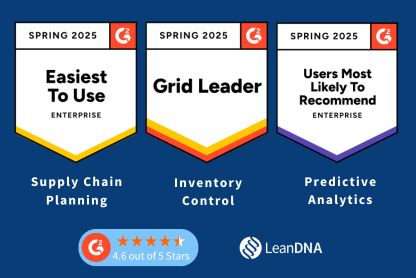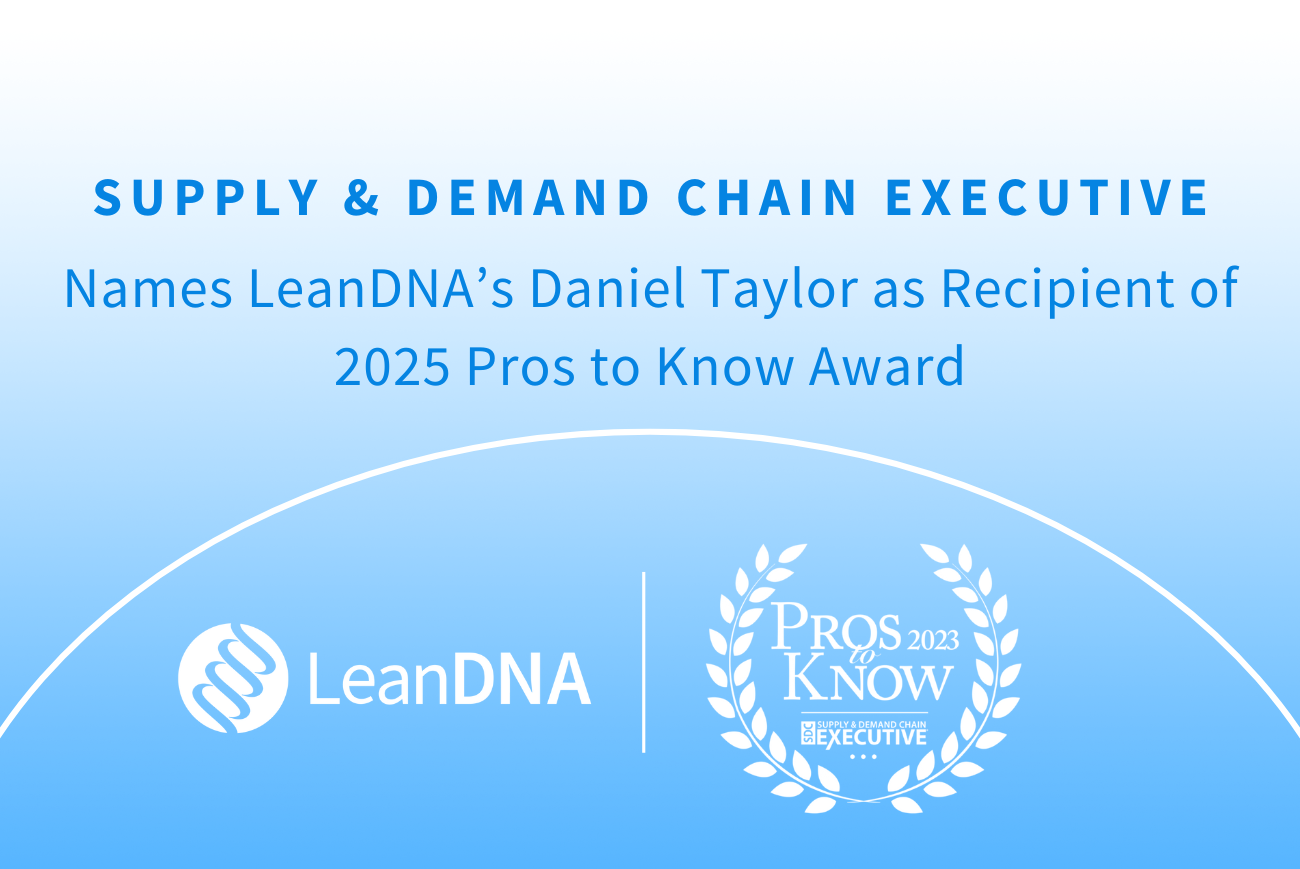Maximizing efficiency of supply chain processes
In a new special edition white paper, the Supply Chain Management Review shows how LeanDNA drives supply chain efficiency by moving the manual procurement process from slow, manual spreadsheet analytic reporting into a high-speed, cloud-based platform that is purpose-built to tie together shortage reduction, supplier management, lean principles, and more.
As the world’s supply chains become more complex and intertwined, effectively leveraging data, making that data actionable, and then getting it into the hands of key decision-makers have all become imperatives for a broad range of companies. Historically, extracting those advanced analytics from the IT department and delivering them to actual users was a cumbersome, time-consuming, expensive process that required an ERP, multiple spreadsheets, phone calls, emails, and myriad other tools.
A type of algorithmic decision-making that helps companies optimize inventory decisions while providing specific actions that they need to take to improve their bottom lines, predictive analytics (here’s what will happen) and prescriptive (here’s what you can do about it with the goal to changing the outcome) analytics are replacing the antiquated ways of leveraging analytics. These two advanced data strategies converge to create a cloud-based solution that provides all the data and reports supply chain professionals to require to gain visibility into today’s most complex operations.
“As inventory and supply chain systems become more complex, they actually require more advanced processes to translate that data and insights to help reduce inventory, improve performance, and increase efficiency,” says LeanDNA CEO Richard Lebovitz. “Embedded in our LeanDNA technology is a prescriptive analytics engine that is based on 25 years of experience implementing supply chain and manufacturing best practices.”
How to Improve Your Manual Procurement Process
LeanDNA takes the analytics fundamentals and incorporates collaboration concepts inside the software, enabling teams to work together to solve inventory problems, surpassing basic spreadsheets, business intelligence engines, and ERP databases by incorporating:
- Inventory data is maintained and analyzed using supply chain analytics software with specific features for inventory optimization.
- Predictive analytics and/or artificial intelligence (AI) to prioritize the most valuable inventory opportunities.
- A high level of cultural accountability for team members (and the company as a whole). LeanDNA creates transparency of assigned actions and results, from individual buyers up to aggregated site-level views, which drives accountability across an organization.
- Extract and store data from any ERP system or other data sources. LeanDNA pulls information from any ERP system, translating it and storing it into a common structure based on manufacturing best practices. Global companies with many different ERP systems can view data across multiple sites with terms that are consistent and easy to understand.
- Multiple people, sites, and disparate ERP systems to pull all inventory data into one place.
In return, companies can effectively optimize inventory and achieve a significant, measurable increase in annual inventory turns. Other key benefits include:
- The ability to document, track, visualize, and understand inventory opportunities throughout your company.
- A solution designed specifically for inventory management based on industry best practices.
- A platform that ties together all of the important facets of inventory management, including shortage reduction, supplier management, and lean principles into a single tool.
- A focus on standard work and best practices that gives team members
- specific daily tasks to optimize time spent and value delivered.
- A culture of connectivity across teams, sites, and ERP systems.
- Automatic root cause analysis to understand the reason behind the inventory issue or shortage, and what specific action to take.
Daniel Taylor, LeanDNA’s Director of Solutions Engineering, says the “culture of connectivity” enabled by a cloud-based prescriptive analytics platform helps break down age-old silos that exist in the manufacturing environment. “A lot of companies are still managing very complex processes offline,” says Taylor, “and with siloed information.”
An aerospace manufacturer that utilizes 10,000 different SKUs to make an aircraft wing over a 2-month span, for instance, faces challenges every time a supplier changes a part number or revises how it makes a certain product. “There are a lot of manufacturing dynamics that flow down to the supply chain group,” says Taylor, “and that require some real, tactical decision-making in order to optimize inventory levels.”
The problems only exacerbate when companies open new physical sites, add new employees, and attract new customers. Unfortunately, ERP data that’s extracted and presented as Excel spreadsheets just doesn’t cut it anymore. Instead, the smart companies are investing in a platform or a “unifying source of truth” that helps them make good supply chain decisions (e.g., it’s time to change this order policy, place a PO with a different supplier, or cut a certain order size in half).
“Our platform ranks those actions and not only empowers buyers, but also rolls right into the C-suite, where executives can clearly see the impact that their teams are having at each site, and how those sites are performing (or not),” says Taylor. “That’s the executives’ dream in a business world where their job is to improve in as many areas as possible.”
Maximizing Supply Chain Efficiency and Value Across Teams and Technology
Because LeanDNA is prebuilt to seamlessly integrate with your existing ERP, the solution can be used throughout every level of an organization, where everyone from the supply chain manager to the procurement professional to the general manager at a specific site can fully leverage the prescriptive analytics it generates. This data can then be leveraged in a way that vastly improves and optimizes inventory. “Our platform is essentially a magnifying glass for an ERP,” says Taylor, “that automatically generates actions that will have the most impact on a daily basis.”
LeanDNA is unique in that it drives value in all levels of the business. Buyers and analysts leverage the tool to make their daily work easier, and managers use it to monitor and improve performance and identify improvement opportunities. By comparison, many platforms are driven by executive decisions, but then struggle to get user adoption. In other cases, users get excited about technology, but then that technology fails to have a measurable impact on the business.
Over 90% of companies have deployed ERP and APS, but inventory levels have grown, not decreased.
Many companies looking to optimize their procurement process are realizing that ERP alone is not enough. Best-of-breed technologies such as LeanDNA help top manufacturers improve their ability to get to data by 15–20% while also improving the effectiveness of decisions. Looking for more from Supply Chain Insights?
Read the full article.
There are many factors that impact the functioning of the global supply chain.
One of the main problems today is rising inflation. Inflation is a huge driver for change as supply chain leaders must adapt their strategies to the changing market. How can manufacturers mitigate this risk in the complex landscape of the manufacturing industry?
Learn more about the impacts of rising inflation on the global supply chain.



